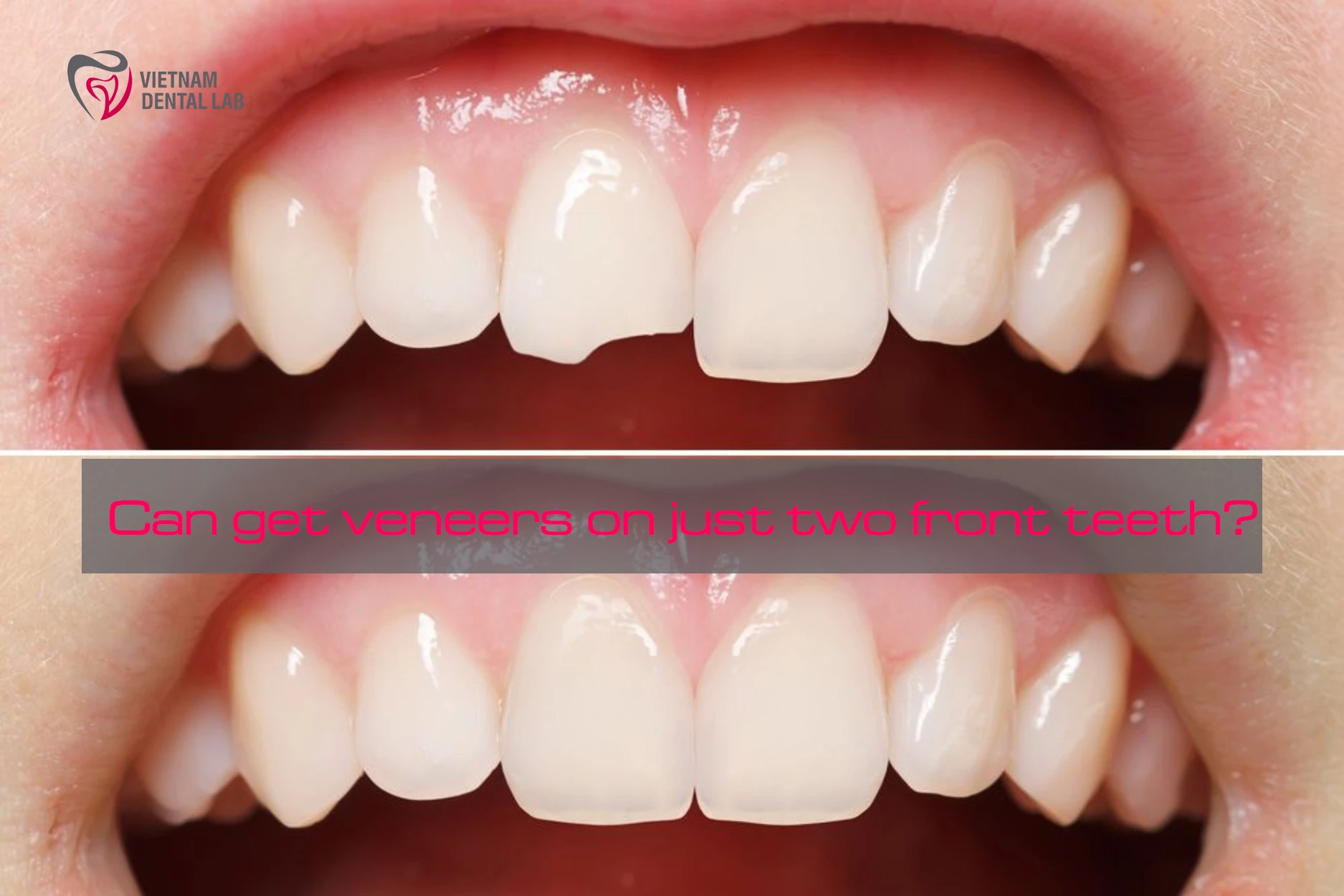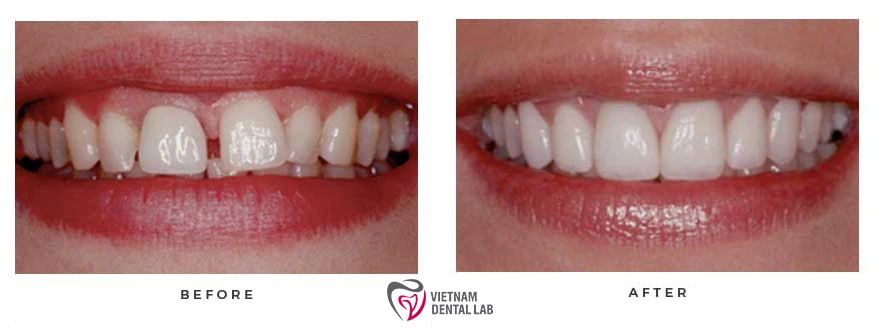Your two front teeth, the central incisors, are the undeniable stars of your smile. They are the most prominent, the most visible, and the teeth that define your smile’s character. So, when they have minor imperfections—a chip, a persistent stain, a small gap, or a slight size imbalance—it’s natural to seek a targeted solution. This leads to one of the most common questions in cosmetic dentistry: “Can I get veneers on just my two front teeth?“
The direct answer is yes, you absolutely can get veneers on just two teeth. It is a common and highly effective procedure for making precise cosmetic enhancements without committing to a full smile makeover.
However, while the procedure is possible, it is considered one of the most artistically demanding tasks in cosmetic dentistry. The true challenge isn’t just placing the veneers; it’s flawlessly matching them to the adjacent natural teeth so they blend in undetectably.
This complete guide will walk you through when getting two veneers is a great idea, the artistic and technical challenges involved, the step-by-step process, cost considerations, and viable alternatives.

When is Getting Veneers on Two Front Teeth a Great Idea?
Applying veneers to only the central incisors is an ideal solution when your surrounding teeth are already healthy, well-aligned, and a color you’re happy with. This targeted approach is perfect for addressing specific, localized issues, such as:
- Correcting Minor Chips, Cracks, or Wear: Everyday life can lead to small chips or fractures on the front teeth. Veneers provide a durable and beautiful way to restore their original shape and strength.
- Concealing Stubborn Intrinsic Stains: Sometimes, stains aren’t on the surface but are inside the tooth (intrinsic). This can be due to medication (like tetracycline) taken during childhood, fluorosis, or trauma. If these stains only affect the front two teeth, veneers can provide a permanent masking solution that whitening can’t fix.
- Closing a Small Gap (Diastema): A gap between the two front teeth is known as a diastema. If the gap is minor, two slightly wider veneers can be designed to close it beautifully and create a more uniform smile line.
- Improving Minor Size or Shape Discrepancies: Genetics can result in front teeth that are slightly undersized (peg laterals, though this affects the adjacent teeth), misshapen, or asymmetrical. Veneers are custom-designed to create the ideal size and shape for a balanced smile.
The Ultimate Challenge: The Art and Science of a Perfect Match
Placing 8 or 10 veneers to create a brand-new, uniform smile is a complex procedure. However, creating just two veneers that are indistinguishable from the natural teeth right next to them requires an even higher level of artistry and technical skill. This is the ultimate test for a cosmetic dentist and their master ceramist.
1. The Color Conundrum
Natural teeth are not a single, flat color. Their shade is a complex interplay of three main properties:
- Hue: The base color (e.g., reddish-brown, yellowish).
- Chroma: The saturation or intensity of the hue.
- Value: The brightness or darkness of the shade.
Furthermore, a natural tooth has translucency, especially near the biting edge, which allows light to pass through. It has subtle color variations from the gum line to the tip. A master ceramist must expertly layer different shades of porcelain to replicate this natural depth and vitality. The final color is also influenced by the shade of the underlying prepared tooth and the color of the dental cement used for bonding.
2. Replicating Shape, Texture, and Light Reflection
Beyond color, the ceramist must perfectly mimic the anatomy of the adjacent teeth.
- Surface Texture: Natural teeth are not perfectly smooth. They have fine horizontal ridges (perikymata) and subtle developmental lobes and grooves that affect how they reflect light.
- Surface Luster: The way a tooth’s surface reflects light contributes to its “alive” appearance. This must be matched perfectly so the veneers don’t look overly glassy or unnaturally dull compared to their neighbours.
- Symmetry and Proportion: The two central incisors should be mirror images of each other. The ceramist must create a veneer that not only matches the adjacent lateral incisor but also perfectly balances its central incisor twin.
3. The Importance of the Dentist-Ceramist Team
Achieving a seamless result with two veneers is impossible without exceptional teamwork between your cosmetic dentist and their dental laboratory technician (ceramist). This process involves:
- High-Resolution Photography: Your dentist will take numerous photos with different lighting and filters to communicate the nuances of shade and texture to the lab.
- Digital Scanning/Impressions: Precise digital scans or physical impressions provide an exact model of your teeth.
- A Detailed Prescription: The dentist writes a detailed lab prescription outlining every characteristic to be replicated.
For this reason, choosing a dentist with extensive experience in partial veneer cases and a proven relationship with a high-end ceramic lab is non-negotiable.
View more: Veneer Digital Dental Design Services

The Step-by-Step Process for Two Front Teeth Veneers
The journey to getting two veneers is meticulous and patient-focused. Here’s what you can expect:
Step 1: The Initial Consultation
You will discuss your aesthetic goals with the dentist. They will perform a comprehensive examination, take X-rays, and determine if you are a good candidate. This is where you can review before-and-after photos of similar cases they have completed.
Step 2: Teeth Whitening (A Highly Recommended Pre-Step)
Before starting the veneer process, it is highly recommended that you professionally whiten your natural teeth. Veneers are color-stable and cannot be whitened later. By whitening first, you establish your desired final shade, and the ceramist can then match the veneers to your newly brightened smile.
Step 3: Tooth Preparation
The dentist will numb your teeth and gently remove a very thin layer of enamel (typically 0.3mm to 0.5mm) from the front surface. This creates space for the veneer to sit flush with the gum line and look natural, not bulky.
Step 4: Digital Impressions and Shade Matching
After preparation, the dentist will take a precise digital scan or impression of your teeth. This is the most critical moment for shade matching, where the dentist will use a shade guide and detailed photos to select and communicate the exact color map for your veneers.
Step 5: Placing Temporary Veneers
You will not leave the office with prepared teeth. The dentist will craft and place temporary veneers, which will protect your teeth and give you a preview of your new smile while the permanent ones are being fabricated by the lab (a process that usually takes 2-3 weeks).
Step 6: The Final Bonding Appointment
Your custom-made porcelain veneers are back from the lab. The dentist will remove the temporaries and place the permanent veneers on your teeth (using a temporary water-based gel) for you to inspect and approve. Once you are thrilled with the look and match, the dentist will permanently bond them to your teeth using a high-strength dental cement and a special curing light.
Cost Considerations for Two Veneers
The cost of dental veneers can vary significantly based on geographic location, the dentist’s expertise, and the material used.
- Porcelain Veneers: For a high-quality, custom-made porcelain veneer from a top cosmetic dentist and master ceramist, you can expect the cost to be between $1,500 and $3,500 per tooth.
- Composite Veneers: A less expensive alternative, composite veneers are hand-sculpted by the dentist in a single visit and typically cost between $400 and $1,000 per tooth.
It’s important to note that the cost per tooth for just two veneers might be slightly higher than the per-tooth cost for a set of eight, due to the intense artistic demand and lab time required for a perfect match. Remember to also factor in the cost of a preceding teeth whitening treatment.
Are There Alternatives to Veneers for Just Two Teeth?
Veneers are a fantastic option, but they aren’t the only one. Depending on your specific issue, you might consider these alternatives:
- Dental Bonding (Composite Bonding): This is the most common alternative. The dentist uses a tooth-colored composite resin to sculpt directly onto the tooth to fix chips, close gaps, or cover stains. It’s less expensive than porcelain, done in one visit, and requires minimal enamel removal. However, it is less durable and more prone to staining over time.
- A Single Dental Crown: If a front tooth is severely damaged, has a large filling, or has had a root canal, a full-coverage dental crown may be a better solution as it provides more structural support.
- Professional Teeth Whitening: If your only concern is the color of your front teeth, a simple professional whitening treatment may be all you need.
- Minor Recontouring (Enameloplasty): For extremely small chips or slight irregularities in length, the dentist may be able to simply recontour and polish the enamel to improve the tooth’s appearance.
Frequently Asked Questions (FAQ)
1. Will my two veneers look fake or obvious?
They absolutely should not. When performed by a skilled cosmetic dentist and fabricated by a master ceramist, the goal is for them to be completely indistinguishable from your natural teeth.
2. How long do veneers on the front teeth last?
With proper care (good oral hygiene, avoiding biting hard objects, wearing a nightguard if you grind), porcelain veneers can last 10-15 years or even longer. Composite veneers typically last 5-7 years before they may need polishing or replacement.
3. Is it necessary to whiten my other teeth first?
It is highly recommended. Matching a veneer to a specific shade is an exact science. If you decide to whiten your teeth later, your natural teeth will get brighter, but your veneers will not, creating a mismatch.
4. What happens if I chip one of my front teeth veneers?
A composite veneer can often be repaired easily by your dentist. A porcelain veneer is much harder to chip, but if it does, it will typically need to be completely replaced.
A Targeted Solution for a Perfect Smile
Getting veneers on just your two front teeth is a powerful and conservative way to achieve a significant aesthetic improvement. It is a procedure that celebrates your natural smile, correcting only what is necessary while preserving the healthy teeth around them.
The success of this treatment hinges almost entirely on the artistic skill of the dental team you choose. By selecting an experienced cosmetic dentist who collaborates with a high-end lab, you can be confident that your two new veneers will blend seamlessly, leaving you with nothing but a beautiful, confident, and perfectly natural-looking smile.
